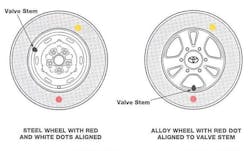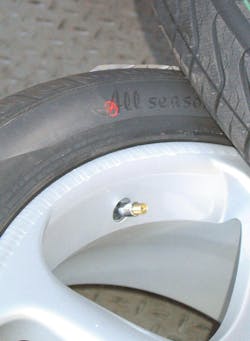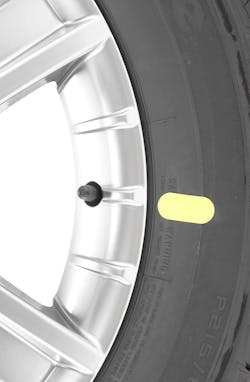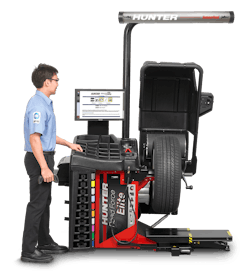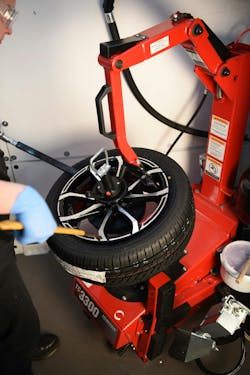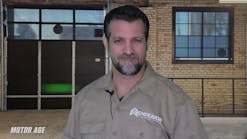Tire-to-wheel match mounting is an effort to minimize the effects of either imbalance or radial force variation (RFV). This is done by mounting the tire onto the wheel in a specific clock position in order to counteract the tire’s high point of RFV to the wheel’s low point or radial runout, or to align the tire’s lightest point of weight to the wheel’s heaviest point of weight. Either of these corrections are traditionally made possible by aligning color dot(s) on the tire to specific locations on the wheel.
Using Dots on Tires
New tires may feature a red dot on the sidewall. This red dot indicates the tire’s uniformity in terms of greatest/highest/stiffest point of radial runout force (maximum RFV). When mounting the tire, this red dot should be aligned to a white dot on the wheel (if the wheel is so marked). The white dot on the wheel indicates the wheel's minimum radial runout point. (On a steel wheel, a dimple may be featured that indicates the wheel’s low point). When using alloy wheels that don’t have a white dot, the tire’s red dot should be aligned with the wheel’s lowest runout point (which may be the valve stem). If the wheels feature no low runout indication, the low runout point may be determined by measuring wheel runout with the use of a dial indicator.
A yellow dot may be found on the tire sidewall which indicates the lightest point of the tire (in terms of weight from a balance consideration). If a yellow dot is found, this should be aligned with the wheel’s valve stem, which should be the wheel’s heavy spot in terms of balance. (The valve stem area becomes more of an issue with the added weight of a TPMS sensor). If the tire features both red and yellow dots, it is preferred to use the red dot as a priority, assuming you can locate the wheel’s low point.
- Red dot on tire (uniformity match): Align to the wheel’s low-point.
- Yellow dot on tire (weight match): Indicates the tire’s lightest point. Align to the wheel’s valve stem.
- Both red and yellow dots on tire: Where possible, the red dot takes priority. Align the red dot to the wheel low point.
NOTE: Not all wheels indicate the point of minimum radial runout. If the point of minimum radial runout is not indicated, and you prefer not to manually measure the wheels for runout, the weight method of match mounting should be used. (Look for the yellow tire mark to pair with the heaviest point of the wheel).
While some tires may feature painted color dots, some tires today use a temporary sticker. The same goes for alloy wheels — a sticker may be present to indicate the wheel’s low spot. Unfortunately, as a result of the handling of the tires and wheels during shipping and subsequent handling in a warehouse or shop, these stickers may have gotten dislodged, eliminating any reference points.
Radial Force Variation
In addition to checking and correcting imbalance issues, we need to consider how tire-to-ground load affects the tire’s rolling uniformity.
Radial force variation (known as RFV) refers to the radial/out of round variation of the tire under load. Note that the term “radial” as used here does not have anything to do with the type of tire (radial or bias ply). Rather, this refers to the radius of the mounted tire in a loaded condition. Given the nature of manufacturing, it’s very difficult if not impossible to make a tire that maintains perfect roundness (consistent radius) when the tire is subjected to load. Due to tire construction where multiple layers of material are involved, there may be a point on the tire that is a bit heavier or stiffer, creating a slight out-of-round when road forces compress the tire due to the isolated area of tire construction stiffness. Vibrations caused by RFV are often mistakenly perceived as an imbalance issue, making the technician or vehicle owner believe that the problem is being caused by a poor balancing job.
These slight variations can result in a vibration at certain speeds, even though the tire and wheel assembly has been weight balanced. In order to fine tune the tire-to-wheel assembly, these slight manufacturing tolerances/tire construction subtleties can be compensated for by match mounting (also known as phase matching). The goal is to align the tire’s point of maximum RFV (the high point of the tire) to the wheel’s point of minimal runout (the low point of the wheel) in an effort to compensate for the dynamic effect of the tire’s high/stiff point.
Radial force is determined by measuring loaded radial runout. On a typical passenger vehicle tire/wheel assembly, 0.001-inch of loaded radial runout is equivalent to about one pound of road force. As an example, a measured 0.030-inch of loaded radial runout (resulting in about 30 pounds of road force) will cause the same amount of vibration as about 2 ounces of wheel imbalance at 50 mph.
A minimum range of between 0.3 to 0.5 ounce (7-14 grams) of imbalance is usually enough for the average motorist to notice an imbalance-induced vibration. If a vehicle is sensitive enough to exhibit noticeable vibration at only 0.3 to 0.5 ounces of imbalance, that same amount of vibration may be present with as little as 10 – 15 pounds of radial force variation. It may be surprising to learn that this can be caused by as little as 0.010” to 0.015” of loaded radial runout. It’s easy to see how loaded runout can dramatically affect vibration. In other words, what may seem as a miniscule level of loaded tire runout variance can result in a notable impact on operating smoothness or harshness.
An Upgrade From the Dots
Unfortunately, the dot placement method is no longer useful in all applications. While the rule of thumb has been to align tire dots to wheels, it has been found that aligning dot markers doesn’t always compensate for weight balance issues or correct a potential RFV, although in theory it should. Today, use of a load force machine is the most accurate method of correcting for RFV.
Red dot alignment may not work with all wheels today, which may require a change in this tire-to-wheel matching approach. Today, some alloy wheels (and even some OE wheels) no longer provide the same valve stem reference points. Due to ever-evolving wheel design, especially in the realm of aftermarket wheels, some alloy wheels now feature the valve stem location that prioritizes aesthetic concerns, rather than indicating a wheel’s point of minimal radial runout. As a result, we can no longer guarantee that valve stem placement is an accurate indication of loaded runout. Yes, this can be somewhat confusing.
This means that match mounting by utilizing the colored dots on the tire may or may not get you “close” to minimizing or eliminating imbalance and/or runout issues.
The only method to accurately achieve correction is to use a balancing machine that enables you to measure runout and load force variations, such as Hunter’s Road Force Elite wheel balancer. This level of balancing equipment automatically measures wheel loaded runout and balance state, providing precise location for adding weights. The tire/wheel assembly is then “road tested” by loading the tire against a load force bar, indicating any radial force variation issue. Resulting data indicates potential need to remount the tire in a different clock position on the wheel in order to minimize or cancel out any RFV.
A balancing machine that incorporates a load feature will not only check for dynamic balance but will also locate the tire’s high spot. If this high spot doesn’t correlate to the wheel’s low spot, the machine will let you know where to relocate the tire on the wheel to minimize RFV.
As you can likely gather at this point, tire “match mounting” is no longer as simple as using the dots on a tire sidewall. An approach to match mounting will depend on several variables.
Regardless of the specific approach you decide to take, it’s important to understand that “stacked-up” runout and imbalance conditions can be diagnosed and addressed.
If you don’t have access to a road force machine, you may continue to use the dot-to-valve stem method (if available). Again, this may or may not minimize the required balance weights, and it may or may not minimize or cancel out a radial runout condition (you can always manually check the wheel for radial runout by mounting the bare wheel to a hub and using a dial indicator), in which case you can continue to use the red dot to align it to the wheel’s point of minimum runout. If imbalance issues persist, move the position of the tire at the wheel by 90-degree increments and test. By relocating the tire relative to the wheel, you can minimize radial runout by locating the tire’s high spot to the wheel’s low spot. Balance weights will likely still be needed, but this may reduce the amount of required weight.
Radial Runout
A perceived imbalance issue may be due to radial runout. Runout may be caused by the hub, wheel-to-hub interface, wheel runout or the mounting position of the tire to the wheel. If dynamic balance is verified, begin measuring for excessive runout. First check hub runout in order to identify or eliminate the hub as the possible root cause of the problem. A stack-up issue is possible if both the hub and wheel feature runout. If the high point of the hub aligns with the high point of the wheel, this compounds the resulting runout condition. If runout of the hub and wheel have been measured independently, re-locate the wheel so that the high points of each component are 180 degrees apart in an effort to cancel the effect.
Inspect Wheels and Tires First
NVH (noise/vibration and harshness) issues can exist due to various conditions involving the vehicle’s suspension, brakes, engine, drivetrain, etc. However, diagnosing and addressing the tire and wheel assemblies offers a good starting point.
Consider the basics first, including tire brand and model (all should be the same), checking for specified tire size, and adjusting all tire inflation pressures to specification. It’s also vital to inspect and feel the tread for unusual wear patterns that may have resulted from worn shocks, incorrect wheel alignment, etc.
Check the tire and wheel for proper bead seating along the entire bead circumference on both sides. An improperly seated bead can easily create a radial runout condition.
As already noted, inspect hub-to-wheel centering, to verify that the degree of wheel centering is even and within the target value of about 0.004" (0.1 mm) maximum. You can always try rotating the wheel to hub position to minimize the issue.

